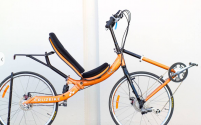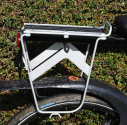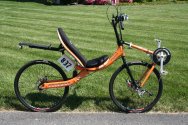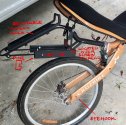David Saxton
New Member
Hi folks,
I was wondering if anyone had any advice or feedback on the Cruise 2.0? There's a used one up for sale in my area for a pretty good price (assuming the condition is decent). I've been eyeing up Cruzbikes for a while but have been unable to commit to buying a new one for lack of ability to test ride and get familiar with the range of bikes.
This would be an inexpensive way for me to get into the brand, and while not the sportiest, I do like this set-up with the rear suspension to use as a commuter / utility bike - possibly even adding an electric motor. I gather that this is a circa 2009 model based on it featuring a 3x9 "SRAM Dual Drive" which was a fairly short-lived product line as I understand.
I'm wondering if anyone knows:
1. If there's an easy way to retrofit or replace the rear rack that's on this bike to carry large panniers? The stock rack looks way minimal, and totally useless for keeping your panniers off of the rear wheel. It appears to be welded onto the seat support tube.
2. If I should be wary of the front boom attachment design with the ginormous riser and separate stem? - I noticed that newer "Q" bikes abandoned this style and instead have the boom connect directly to the handlebars like the S and V series do. That said, I don't mind the mustache bars, that's a comfortable if not-the-most-aero way to roll.
3. Does this bike have front suspension? It almost looks like it has a pivot in front and then maybe a head shock type thing int the fork?
4. Does the rear shock work in this design? Stroke and eye-to-eye length looks incredibly short compared to what I'm used to from mountain bikes, but maybe it's enough to yield a bit of travel for road use?
5. Can a headrest be added?
Thank you for any advice you have - there's such a depth of knowledge on this forum, I figured there's probably at least one person who's ridden on or tinkered with this model of bike before.
Side note: the Q's in general seem like a good candidate for a "rear" wheel electric motor conversion (using a "front" wheel kit) and this one certainly fits the bill since it uses older QR dropouts like the Bafang hub motors need. Not sure where I'd put the battery, but probably there's a way to strap it to the bottom of the frame, and it's convenient that there's just the one brake line to worry about routing around.

I was wondering if anyone had any advice or feedback on the Cruise 2.0? There's a used one up for sale in my area for a pretty good price (assuming the condition is decent). I've been eyeing up Cruzbikes for a while but have been unable to commit to buying a new one for lack of ability to test ride and get familiar with the range of bikes.
This would be an inexpensive way for me to get into the brand, and while not the sportiest, I do like this set-up with the rear suspension to use as a commuter / utility bike - possibly even adding an electric motor. I gather that this is a circa 2009 model based on it featuring a 3x9 "SRAM Dual Drive" which was a fairly short-lived product line as I understand.
I'm wondering if anyone knows:
1. If there's an easy way to retrofit or replace the rear rack that's on this bike to carry large panniers? The stock rack looks way minimal, and totally useless for keeping your panniers off of the rear wheel. It appears to be welded onto the seat support tube.
2. If I should be wary of the front boom attachment design with the ginormous riser and separate stem? - I noticed that newer "Q" bikes abandoned this style and instead have the boom connect directly to the handlebars like the S and V series do. That said, I don't mind the mustache bars, that's a comfortable if not-the-most-aero way to roll.
3. Does this bike have front suspension? It almost looks like it has a pivot in front and then maybe a head shock type thing int the fork?
4. Does the rear shock work in this design? Stroke and eye-to-eye length looks incredibly short compared to what I'm used to from mountain bikes, but maybe it's enough to yield a bit of travel for road use?
5. Can a headrest be added?
Thank you for any advice you have - there's such a depth of knowledge on this forum, I figured there's probably at least one person who's ridden on or tinkered with this model of bike before.
Side note: the Q's in general seem like a good candidate for a "rear" wheel electric motor conversion (using a "front" wheel kit) and this one certainly fits the bill since it uses older QR dropouts like the Bafang hub motors need. Not sure where I'd put the battery, but probably there's a way to strap it to the bottom of the frame, and it's convenient that there's just the one brake line to worry about routing around.






